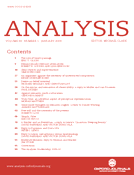-
Views
-
Cite
Cite
Alan Millar, The Measure of Mind: Propositional Attitudes and their Attribution
By Robert J. Matthews, Analysis, Volume 69, Issue 1, January 2009, Pages 185–187, https://doi.org/10.1093/analys/ann030Close - Share Icon Share
Extract
The deflationary aim of this book, which occupies Part I, is to show that a widely held view has little to be said for it. The constructive aim, pursued in Part II, is to make plausible a measure-theoretic account of propositional attitudes. The discussion is throughout instructive, illuminating and sensitive to the many intricacies surrounding attitude ascriptions and how they can carry information about a subject's psychology. There is close engagement with cognitive science. The book should be read by anyone seriously engaged with issues about propositional attitudes.
According to the widely held view, which Matthews calls the Received View, the attitude of Φing that p is a matter of standing in a computational/functional relation to an explicit Representation that expresses the proposition that p, and thinking is ‘an inferential computational process defined over one or more of these Representations that eventuates in the production of either another Representation or a behavior’ (20). The representations are understood to be sentences in a language of thought and thus to have a compositional syntax and semantics (21). The theory that Matthews aims to make plausible has it that ascriptions of propositional attitudes in the form ‘X Φs that p’, ascribe a state to a person by relating that person to an abstract object that is the representative of the state in roughly the way that numbers on a scale are the measure-theoretic representations of certain physical magnitudes (cf. 117). We are to think of the role of ‘Jones believes that interest rates will fall’ by analogy with that of ‘Jones weighs 150lbs’. The latter depends on there being arithmetical relations defined over numbers that enable its particular assignment of a number to Jones's weight to represent physical properties that Jones has in virtue of weighing 150 lbs. The analogue of arithmetical relations in the case of beliefs is, roughly speaking, inferential relations. Saying of Jones that he believes that interest rates will fall represents Jones as being in a state that is apt to have certain characteristic effects. The attribution's specification of the content of the attitude is a measure of the aptitude of Jones to exhibit the characteristic effects.




